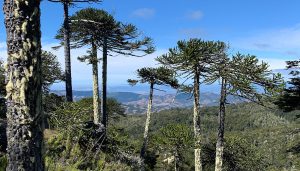Very conspicuous along the Royal Walk, but in fact misplaced between the North American arboretum groups, are the so-called Monkey Puzzle trees that adorn and enliven Group 10. Their scientific name, Araucaria araucana, is derived from the native Araucanians whose diet included the seeds of this tree. These trees are armored with sharp and smooth leaf-scales, a remnant of pre-Paleolithic times, which makes them unapproachable. The Araucarias are flanked by a few Southern beeches, a species that, although it is classified in the same taxonomic order of Fagales, has little in common with the European beech that thrives in our forests. Plant species of the Southern Hemisphere have little in common with those of the Northern Hemisphere. However, some Southern beech trees are known for their sturdy and robust hardwood, the Roble pellín (Nothofagus obliqua) being one example. (Its name can lead to some confusion: roble is Spanish for oak). The shrub-shaped Ñirre or Antarctic beech with its fine serrated leaves is sometimes used as an ornamental plant in gardens. The evergreen Magellan’s beech, also part of this group, is also very attractive.


